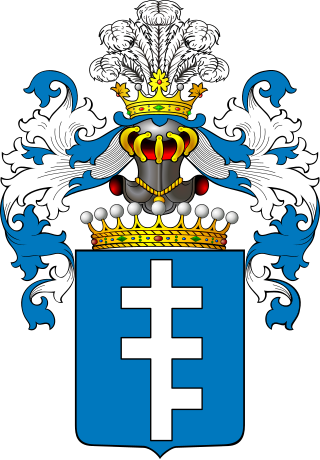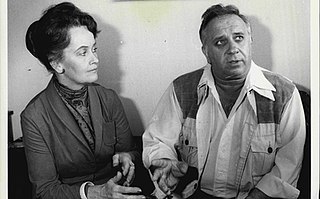
Down syndrome or Down's syndrome, also known as trisomy 21, is a genetic disorder caused by the presence of all or part of a third copy of chromosome 21. It is usually associated with physical growth delays, mild to moderate intellectual disability, and characteristic facial features. The average IQ of a young adult with Down syndrome is 50, equivalent to the mental ability of an eight- or nine-year-old child, but this can vary widely.

Asperger syndrome (AS), also known as Asperger's, is a former neurodevelopmental disorder characterized by significant difficulties in social interaction and nonverbal communication, along with restricted and repetitive patterns of behaviour and interests. The syndrome is no longer recognised as a diagnosis in itself, having been merged with other disorders into autism spectrum disorder (ASD). It was considered to differ from other diagnoses that were merged into ASD by relatively unimpaired spoken language and intelligence.

Turner syndrome (TS), also known as 45,X, or 45,X0, is a genetic condition in which a female is partially or completely missing an X chromosome. Signs and symptoms vary among those affected. Often, a short and webbed neck, low-set ears, low hairline at the back of the neck, short stature, and swollen hands and feet are seen at birth. Typically, those affected do not develop menstrual periods, or breasts without hormone treatment and are unable to have children without reproductive technology. Heart defects, diabetes, and low thyroid hormone occur in the disorder more frequently than average. Most people with Turner syndrome have normal intelligence; however, many have problems with spatial visualization that may be needed in order to learn mathematics. Vision and hearing problems also occur more often than average.

Lorraine Bracco is an American actress. Known for her distinct husky voice and Brooklyn accent, she has been nominated for an Academy Award, four Emmy Awards, four Golden Globe Awards, and three Screen Actors Guild Awards.
Parental alienation syndrome (PAS) is a term introduced by child psychiatrist Richard Gardner in 1985 to describe signs and symptoms he believed to be exhibited by children who have been alienated from one parent through manipulation by the other parent. Proposed symptoms included extreme but unwarranted fear, and disrespect or hostility towards a parent. Gardner believed that a set of behaviors that he observed in some families involved in child custody litigation could be used to diagnose psychological manipulation or undue influence of a child by a parent, typically by the other parent who may be attempting to prevent an ongoing relationship between a child and other family members after family separation or divorce. Use of the term "syndrome" has not been accepted by either the medical or legal communities and Gardner's research has been broadly criticized by legal and mental health scholars for lacking scientific validity and reliability.

The House of Potocki was a prominent Polish noble family in the Kingdom of Poland and magnates of the Polish–Lithuanian Commonwealth. The Potocki family is one of the wealthiest and most powerful aristocratic families in Poland.
Abraham ben Abraham, also known as Count Valentine Potocki, was a purported Polish nobleman (szlachta) of the Potocki family who converted to Judaism and was burned at the stake by the Roman Catholic Church because he had renounced Catholicism and had become an observant Jew. According to Jewish oral traditions, he was known to the revered Talmudic sage, the Vilna Gaon, and his ashes were interred in the relocated grave of the Vilna Gaon in Vilna's new Jewish cemetery.

Edward Warren Miney and Lorraine Rita Warren were American paranormal investigators and authors associated with prominent cases of alleged hauntings. Edward was a self-taught and self-professed demonologist, author, and lecturer. Lorraine professed to be clairvoyant and a light trance medium who worked closely with her husband.
Smith–Magenis Syndrome (SMS), also known as 17p- syndrome, is a microdeletion syndrome characterized by an abnormality in the short (p) arm of chromosome 17. It has features including intellectual disability, facial abnormalities, difficulty sleeping, and numerous behavioral problems such as self-harm. Smith–Magenis syndrome affects an estimated between 1 in 15,000 to 1 in 25,000 individuals.

Severe acute respiratory syndrome coronavirus 1 is a strain of coronavirus that causes severe acute respiratory syndrome (SARS), the respiratory illness responsible for the 2002–2004 SARS outbreak. It is an enveloped, positive-sense, single-stranded RNA virus that infects the epithelial cells within the lungs. The virus enters the host cell by binding to angiotensin-converting enzyme 2. It infects humans, bats, and palm civets.
RAI1 is a transcription factor associated with Smith–Magenis syndrome when individuals have deletions of the gene and Potocki–Lupski syndrome when individuals have a duplication. It is known as retinoic acid induced 1.

Homeobox protein aristaless-like 4 is a protein that in humans is encoded by the ALX4 gene. Alx4 belongs to the group-1 aristaless-related genes, a majority of which are linked to the development of the craniofacial and/or appendicular skeleton, along with PRRX1, SHOX, ALX3, and CART1. The Alx4 protein acts as a transcriptional activator and is predominantly expressed in the mesenchyme of the developing embryonic limb buds. Transcripts of this gene are detectable in the lateral plate mesoderm just prior to limb induction. Alx4 expression plays a major role in the determination of spatial orientation of the growing limb bud by aiding in the establishment of anteroposterior polarity of the limb. It does this by working in conjunction with Gli3 and dHand to restrict the expression of Sonic Hedgehog (SHh) to the posterior mesenchyme, which will eventually give rise to the Zone of Polarizing Activity (ZPA). This gene has been proven to be allelic with mutations and deletions giving rise to a host of craniofacial dismorphologies and several forms of polydactyly in mammalian development. A mouse-model knockout of this gene, dubbed Strong's luxoid, was originally created by Forstheofel in the 1960s and has been extensively studied to understand the partial and complete loss-of-function properties of this gene.
Low copy repeats (LCRs), also known as segmental duplications (SDs), are highly homologous sequence elements within the eukaryotic genome.
Potocki–Lupski syndrome (PTLS), also known as dup(17)p11.2p11.2 syndrome, trisomy 17p11.2 or duplication 17p11.2 syndrome, is a contiguous gene syndrome involving the microduplication of band 11.2 on the short arm of human chromosome 17 (17p11.2). The duplication was first described as a case study in 1996. In 2000, the first study of the disease was released, and in 2007, enough patients had been gathered to complete a comprehensive study and give it a detailed clinical description. PTLS is named for two researchers involved in the latter phases, Drs. Lorraine Potocki and James R. Lupski of Baylor College of Medicine.
Potocki–Shaffer syndrome (PSS), also known as DEFECT11 syndrome or chromosome 11p11.2 deletion syndrome, is a rare contiguous gene syndrome that results from the microdeletion of section 11.2 on the short arm of chromosome 11 (11p11.2). The syndrome has its name from Dr. Lorraine (Lori) Potocki and Dr. Lisa Shaffer who discovered the deletion on the 11th chromosome and studied the impacts.
Alopecia contractures dwarfism mental retardation syndrome or is a developmental disorder which causes mainly baldness and dwarfism in combination with intellectual disability; skeletal anomalies, caries and nearsightedness are also typical.
A microdeletion syndrome is a syndrome caused by a chromosomal deletion smaller than 5 million base pairs spanning several genes that is too small to be detected by conventional cytogenetic methods or high resolution karyotyping. Detection is done by fluorescence in situ hybridization (FISH). Larger chromosomal deletion syndromes are detectable using karyotyping techniques.

Count Jerzy Józef Henryk Potocki was a Polish nobleman, captain of the cavalry and diplomat.

Long COVID or long-haul COVID is a condition characterized by long-term health problems persisting or appearing after the typical recovery period of COVID-19. Although studies into long COVID are under way, as of May 2022 there is no consensus on the definition of the term.










